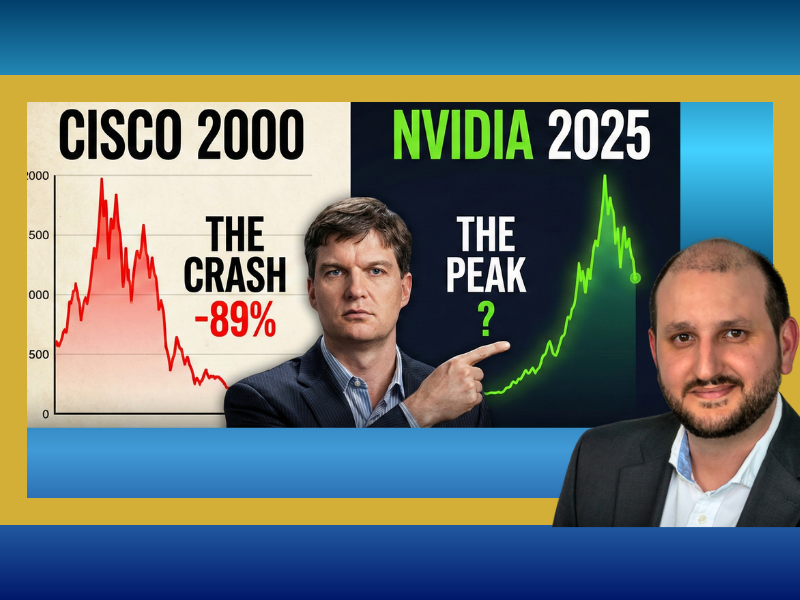The Storm is Here: How to Navigate a Stock Market That's Flashing Sell Signals
- Nico DE BONY
.jpg/v1/fill/w_320,h_320/file.jpg)
- Aug 6
- 3 min read

For weeks, we’ve seen the clouds gathering. Now, the storm has arrived. The market has shifted from a state of euphoria to one of high alert, with key indicators flashing sell signals. We are likely in the beginning stages of either a significant pullback or a new bear market.
The challenge is that every storm is different. We could be facing a short-term squall, like the 15-20% corrections we saw last summer and this spring. Or, this could be the start of something more severe, echoing the sharp COVID crash, the 2022 bear market, or even the 2008 financial crisis.

While we can't predict the storm's exact path, we can prepare our ship. This isn't a time for panic; it's a time for disciplined, strategic action. Here are four signals that show the market's foundation is cracking and what they mean for your strategy.
1. The Canary in the Coal Mine: Utilities vs. The Market

A classic warning sign has returned: a sharp divergence between utility stocks (XLU) and the broader S&P 500 (SPY). We saw this exact pattern unfold before the COVID crash and last year's 15% sell-off. While the S&P 500 pushed to new highs, utilities lagged, suggesting "smart money" was quietly moving to safety. This quiet vote of no-confidence is a powerful signal that the market's momentum is not as strong as it appears on the surface.
2. The Gold Breakout: A Clear Flight to Safety

Gold is often a safe haven during uncertainty. It is currently breaking out of a "massive bull flag pattern," a technical indicator pointing to a potential 20% surge. This is reminiscent of 2007-2008, when gold rallied before the major market downturn. Large-cap gold miners have already started to move higher, which is often a leading indicator for the price of physical gold. This clear move toward assets that offer protection shows that confidence in the broader market is fading.
3. The Economic Disconnect: Weak Data vs. Unstable Highs
A sustainable market rally needs a strong economy, yet recent data confirms a slowdown. The latest jobs report was much weaker than expected, and it’s part of a larger trend of economic softening. Meanwhile, retail investors are dangerously over-leveraged, with margin debt at an all-time high. A weakening economy cannot support a market fueled by borrowed money forever. This combination creates a fragile system vulnerable to shocks.
4. The Broken Shield: Why Bonds May Not Be the Safe Haven You Expect

Historically, investors fled to bonds for protection when stocks fell. However, that relationship has been unreliable since 2022. While bonds are currently rallying as a defensive play, they are in a long-term downtrend, stuck in what technicians call a "stage one base." This pattern can last for years, meaning bonds could offer frustratingly little upside or protection. Relying on them as your sole defensive tool is a high-risk strategy in the current environment.
From Investor to Navigator: What You Can Do

In a storm, you don't need a crystal ball, you need a compass and a sturdy vessel. This is where you shift from being a passive investor to an active navigator of your own financial future.
It's crucial to understand that my role at OPTI Strategies is not to provide financial advice. I don't tell you what to buy or sell. Instead, I provide educational coaching. I teach you how to read the signals, understand the tools, and implement risk-management strategies yourself. I empower you to make your own informed decisions with confidence and clarity.
The goal is to move from fear and uncertainty to a state of peace of mind, knowing you have a plan in place to protect your hard-earned capital.
If you feel unprepared for this market shift and want to learn how to build a resilient strategy, let's talk. I invite you to book a free strategy call to determine if my educational coaching approach is the right fit for you.
-----
PS: I received a very good question and wanted to share the answer with you!
Essentially: how do you follow market signals without abandoning your long-term plan? 🤔
My approach isn't to guess, but to use clear signals to better manage risk. Here's an analogy: your plan is your travel destination. The market signals are the weather. You don't cancel a trip for a storm, but you adapt your driving to travel safely.
The goal is to protect your capital for the long term, not to make a quick profit. Avoiding a major drop is the best way to ensure your plan's success.
You have to be strategic, not static. Buying and simply hoping it goes up is risky. It's better to have tools to protect yourself during periods of turbulence.
I hope this helps clarify the approach!
%20-%20WO%20BG.png)


